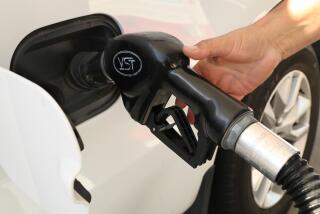Gas Prices Up; Cause Debated
While crews clean up the largest oil spill in U.S. history, Orange County gas station owners have been forced to raise prices at the pumps by as much as 10 cents a gallon--a hike that some say they resent.
“We have so much oil in this country,” said an employee at Ray’s Super Shell station in Stanton. “My belief is the oil companies are using (the spill) to raise prices. The prices had been going up a little at a time for a couple of months, but after the spill, they really started jacking up the prices.”
All of the station owners and managers contacted Thursday agreed that prices have increased since the supertanker Exxon Valdez ran aground off Valdez on the Alaskan coast Friday, preventing other tankers from entering the port to take on crude oil. The closure of the port reduced the flow through the Trans-Alaska Pipeline, which terminates in Valdez, by 40%. Although the port was reopened on Wednesday, tanker traffic has continued to move slowly.
One Chevron USA official estimated that by this weekend, the oil industry will have lost 10 million barrels of crude oil production. California gets 40% of its oil from Alaska.
But even before the spill, gas station owners said, prices had been inching up in anticipation of the summer demand.
Steve Shelton, executive director for the Southern California Service Station Assn., said that prices have increased an average of 16 cents over the last 3 months.
Pete Peterson, manager of Lambert Chet Chevron in Fullerton, said: “The gas prices always go up for the summer.” Customers “don’t inquire about the prices. They just (complain). But they have become accustomed to it now.”
Peterson and other dealers said prices always start moving up before the summer months and then decrease in September. But most said the increase started earlier this year.
“It’s credited to greed, not the spill,” Peterson said. “I guess they (oil companies) just want it sooner.”
“It seems that it started earlier this year and has been on a faster increase than in past years,” said Lance Knight, owner of Knight Union in Costa Mesa.
Knight, who has raised his prices 4 cents since the spill, said he attributes the unusual hike to increased demand. He said a survey found that 43,000 cars go through his intersection at Harbor Boulevard and MacArthur Avenue each day, compared to 34,000 a year ago.
Of the stations contacted, the average increase since the spill amounted to 4 cents. The highest increase was 10 cents at Bob’s Mobil in Mission Viejo. Ray’s Super Shell in Stanton reported a 9-cent increase and J & M Self Service Texaco in Corona del Mar posted an 8-cent increase.
The lowest increase was 2 cents. Three of the six stations that reported a 2-cent increase were Exxon stations.
“If you look at the history of the business,” Shelton said, “it’s true that the oil companies have exploited any interruption of supply as a reason to raise prices. But I’m talking about embargoes and political events. I’m not saying that’s happening now, but I’m not going to bet against it.”
Some customers said Thursday that they had noticed the increases and were not looking forward to more.
“I didn’t notice it until just recently. It’s going up like heck,” said Jerry Estrada of Mission Viejo. “I think it’s kind of bogus myself. But I have no choice. The best thing I can do is pay cash.”
Marie DiPasquale of Huntington Beach figures gas is “a necessity; it doesn’t matter if it goes up or down. There is no sense in bickering about it. But the spill should not affect us. We shouldn’t have to pay the penalty for that.”
More to Read
Sign up for Essential California
The most important California stories and recommendations in your inbox every morning.
You may occasionally receive promotional content from the Los Angeles Times.









